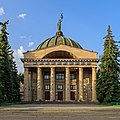Vasily Nikolayevich Simbirzew
Vasily Nikolayevich Simbirzew ( Russian Василий Николаевич Симбирцев ; born January 1 . Jul / 14. January 1901 greg. In St. Petersburg ; † 19th October 1982 in Moscow ) was a Russian architect and university lecturer .
Life
Simbirzew began studying painting in Moscow in 1921 - the Faculty of Higher Artistic-Technical Workshops . 1922–1928 he studied at the Leningrad Higher Artistic-Technical Institute with Nikolai Alexandrowitsch Ladowski , Vladimir Fyodorowitsch Krinsky , NW Dokuchajew and finally with Alexander Alexandrowitsch Wesnin . From 1929 he taught at the Moscow Architecture Institute (MArchI).
1929 founded Simbirzew together with Alexander Wassiljewitsch Vlasow , Karo Halabjan , Vladimir Babenkow and Viktor Baburow the All-Russian Association of Proletarian Architects (WOPRA) , in whose management he joined. WOPRA rejected constructivism and sought a new architectural style in line with the political system of the Soviet state. To do this, the method of Marxist analysis should be applied to the analysis of the art of previous generations.
1933–1934 Simbirzew worked in Iwan Wladislawowitsch Scholtowski's studio . In the competition for the Palace of the Soviets in 1933 he and Karo Halabjan received first prize for their joint project . Together with Karo Halabjan, he carried out the project for the construction of the Central Academic Theater of the Red Army in Moscow from 1934 to 1940. With Boris Grigoryevich Barchin he built the pavilion of the Belarusian Soviet Socialist Republic at the All- Union Agriculture Exhibition in Moscow from 1938 to 1939 . He built houses in Moscow on Krasnosselskaya Ulitsa, on Leningradskoje Chaussee and on Tverskoy Bulwar. At the beginning of the German-Soviet War in 1941 he became an architect and engineer for defense construction in and around Moscow.
From 1944 to 1959 Simbirzew was the main architect of the city of Stalingrad (from 1961 Volgograd). In the city, which was largely destroyed by the Battle of Stalingrad , he and his colleagues built, among other things, the Alley of Heroes , the Square of the Fallen Fighters , the party universities in Stalingrad (1950 with Yefim Iossifowitsch Levitan , now Medical University) and Khabarovsk (now the Far East Academy of State Services ), the planetarium and the central Wolgauferstraße . He also directed the reconstruction of the Kazan Cathedral . He also taught at the Stalingrad Engineering Institute for Urban Economics. His successor was Vadim Efimowitsch Masljajew as the main architect of Stalingrad and Volgograd.
From 1959 Simbirzew worked in Moscow. He developed experimental projects and worked scientifically. In 1961 he became a member of the CPSU . He worked on a general plan for Irkutsk and designed a residential area in Vladivostok .
Simirzew died in Moscow and was buried in Leningrad in the Bogoslovskoye Cemetery. A street in Volgograd bears his name.
Honors, prizes
- Medal "For heroic work in the Great Patriotic War 1941–1945"
- Stalin Prize, 2nd class (1951) for the architecture of the party college in Stalingrad
- Order of the Red Banner of Labor
- Anniversary medal "In memory of the 100th birthday of Vladimir Ilyich Lenin"
- Honored Architect of the People of the USSR (1975)
Works
Individual evidence
- ↑ a b c d e f g h i Great Soviet Encyclopedia : Симбирцев Василий Николаевич (accessed April 10, 2019).
- ↑ a b c d e f g Tramwaj Iskusstw: Симбирцев Василий Николаевич (1901–1982) Биография (accessed April 10, 2019).
- ↑ a b c Nekropol Sankt-Peterburga: Симбирцев Василий Николаевич (1901–1982) (accessed April 10, 2019).
- ↑ Щеглов А. В .: Очерки по истории Союза архитекторов России . Союз архитекторов России, Moscow 2004, ISBN 978-5-4316-0185-9 , p. 71 .
- ↑ Иконников А. В .: Архитектура XX века. Утопии и реальность. Т. 1 . Прогресс-Традиция, Moscow 2001, ISBN 5-89826-096-X , p. 328, 451, 481 .
- ↑ Олейников П.П., Олейникова Е.П., Трофимов С.Н .: Главные городские архитекторы Сталинграда . In: Интернет-вестник ВолгГАСУ. Политематическая сер. tape 1 , no. 10 , 2010, p. 1–5 ( [1] accessed April 10, 2019 [PDF]).
| personal data | |
|---|---|
| SURNAME | Simbirzew, Wassili Nikolajewitsch |
| ALTERNATIVE NAMES | Симбирцев, Василий Николаевич (Russian) |
| BRIEF DESCRIPTION | Russian architect and university professor |
| DATE OF BIRTH | January 14, 1901 |
| PLACE OF BIRTH | St. Petersburg |
| DATE OF DEATH | October 19, 1982 |
| Place of death | Moscow |







